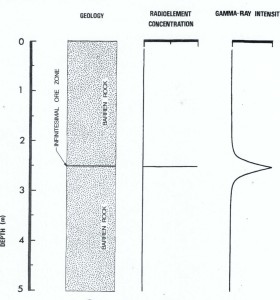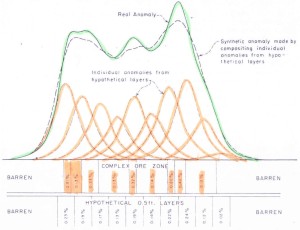Deconvolution of gamma logs
Deconvolution is a common process in seismic process where the objective is to “sharpen” the seismic response at depth. The process is necessary as the earth through which the seismic source pulse travels is altered by the rocks which act as a filter to broaden the seismic response at depth.
The rock in a uranium bearing sequence acts in the same way, acting as a filter to broaden the gamma response. Deconvolution of gamma logs aims to strip off the geological effect and realise the in situ distribution of the uranium ores.
Additional to these effects are the probe housings and detector size and electronics, all combining to potential reduce the accuracy of the gamma logs.
At present, deconvolution of gamma logs is considered as specialised processing hence its use has been limited. Furthermore whether the process is actually necessary is sometimes questioned by Uranium geologists.
Recent work by Bruce Dickson has proposed another method for deconvolution of gamma logs using space domain filtering and inputs for detector size and uranium ore zone thickness. Software is being developed to apply Dickson’s work to current gamma data sets.
Gamma logs
Gamma logs are a fundamental part of cost effective uranium exploration. Ideally we would like gamma logs to give exact information on the quantity and distribution of uranium ore with depth along the borehole. In the ideal world, the gamma log intensity would be exactly proportional to the uranium grade and any given depth. However, there are many factors which interfere with the ideal log and distort the shape of the gamma response.
The distortion of the gamma response is related in part to the physical properties of the surrounding rock (known as the geological impulse function) and in part to the features and design of the measuring equipment (known as the system response). It is said the geological and system factors are convolved together with the uranium distribution
The example above is interpreted as a series of very thin uranium bearing zones, yet the gamma log response shows a complex peak anomaly – mixing the response of the all thin zones. the aim of deconvolution is to resolve the gamma data back to the thin uranium bearing zones, free of local geological and logging system effects


